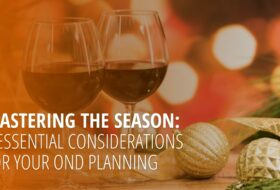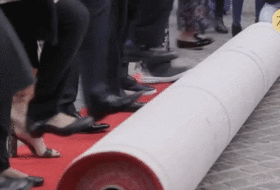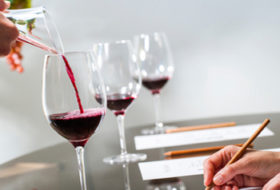While there has been a dry spell of events, it seems that more than ever, people are wanting to get back to gathering. Events had been second nature, but it’s been a while and we’re all a bit rusty so let’s have a refresher on these shindigs as well as the benefits and challenges of the different formats! We’ll discuss the how, where, and why of events to address three critical questions that arise as part of formulating an event plan.
How will the event be held? In-person vs Virtual Experience (VX) Events
In-person events:
Benefits – The value of connecting with guests in person never gets old. There’s something about smiling face to face, shaking hands, the celebratory ‘ting-ting’ of clinking glasses as a ‘cheers’ goes around that resonates on a deep and personal level. This level is where memories are forged and that, my friend, is the name of the game in our business. Helping guests make memories creates emotional ties to the brand, cementing it as part of someone’s personal history. Do this and you’ll have fans for life! In-person events allow for conversations to naturally spark between the guests themselves as well as the winery team and the guests. These easy, breezy connections are the best ways to introduce new customers to the brand and the format makes a wine sales and club sign-up pitch feel natural – like an invitation to keep in touch or be a part of the family.
Challenges – In-person events typically have a higher cost to the winery. Rentals, catering, staffing, and having plenty of wine available are the bigger expense factors. With staff in short supply these days, there may be a need to break what had been larger events into several small events in order to have enough labor set up, entertain & pour, and break down. Weather is another factor to be considered with in-person events and is unpredictable though it can be mitigated with shade structures, heat lamps, or tenting but again, these are additional costs that eat into the event budget.
Virtual Experience (VX) Events:
Benefits – The ease of accessibility as well as the wide reach of VX events has been proven in this past year. The ability to meet people where they are is a huge benefit to hosting virtual gatherings. These can range from intimate private tastings to Instagram Live cooking and wine pairing demos with a professional chef and the winemaker! The possibilities are truly endless with this format because of the low barrier to entry for the guest and the winery. Little to no rentals, no venue or facility fees, a fraction of the staffing of in-person events, consumption is a bit lower, and the ability to record and leverage the content created in the VX event long after it’s over. VX events are great for keeping members connected and engaged or for hosting corporate events and tastings. Having a back-up rain or heat plan is far easier with these events since there are far fewer people to accommodate in inclement weather.
Challenges – Delving into deep personal connections through one-to-one conversations with guests, asking for the sale, and general ‘community’ feel are a few of the trickier parts of the virtual vibe. Wine sales and clubs can also be a bit challenging to pitch in this format. It can difficult to create deep and meaningful connections with some guests who are unfamiliar with the brand over VXs – though it can certainly work for some customers, others need the sensory, physical experience of being at the winery and face to face with their host.
Where will the event be held? Onsite vs Offsite
Onsite:
Benefits – Hosting events at the winery taps into the heart of what consumers love about the wine world. It’s home base, it’s where the magic happens. They want to be as close to the source as possible. There is no need to pay a venue fee and, in many cases, the event can be staffed by tasting room employees if there is flexibility in schedules. Wine is easily accessed along with extra glassware, collateral, and any necessary extras (wine openers, additional bottles if any are flawed). There’s a comfort level in being ‘at home’ at the winery and there’s no fee for going over allotted time blocks.
Challenges – Onsite events can draw from resources needed for other DTC channels. For instance, many events onsite will likely be staffed with tasting room and wine club team members which means that they turn their focus away from their daily tasks to support the event. They may not be able to answer phones, email, or take care of tasting guests at the level that is typically staffed. The tasting room may even need to shut down for some of all of the time that the event is happening due to space and staff limitations.
Offsite:
Benefits – Taking the show on the road can take on many forms. Hosting at an offsite venue may be a means to accommodate a higher guest count, to have access to catering or a specific chef, to align the brand with a particular experience (think fishing or a ballgame to create a casual vibe, polo or European river cruise to create an exclusive or luxury feeling), or to create a cobranding opportunity with the venue itself (think high-end resort, golf club, art gallery). There is a draw for both fans of the winery as well as people near the event space or those on the mailing list of the venue which creates an opportunity to expand reach and interest. It’s important to collect data at all events but especially at these offsite events!
Challenges – Being away from home means packing and planning! Thinking through each detail and convenience that would be required at an onsite event and translating it to another venue can be difficult. It’s helpful to have a firm understanding of what the venue provides and what you’ll need to supplement. Also, run through the same checklist as an onsite event to ensure nothing is missed.
Why is the event being held? Revenue Generators vs Retention & Appreciation
Revenue Generators:
Benefits – Stating the obvious here, but the benefit is (drumroll, please) revenue! If hosting a revenue generating event, there are likely ticket sales and wine sales involved. Ticket sales ensure that attendees are committed to the brand or the event and also weeds out attendees that come for the free food, wine, and/or entertainment. Tickets can help get the right people in the door. Wine sales indicate that the message or intent of the event resonated with the attendees, that there was a connection created or nurtured. Wine sales opens the door to the next level of relationship with purchasing consumers. Send ‘thank you’ notes, invite them back, or offer referral incentives to keep your winery top of mind for them. Bringing in revenue also helps to cover additional staffing or elevated food
Challenges – The barrier to entry is a bit higher and may cut off entry level consumers that may ‘age up’ or graduate to the brand. Expectations are higher when customers pay for a ticketed event so be ready to deliver.
Appreciation & Gratitude:
Benefits – Events to show appreciation for members & loyal customers, locals, and industry folks, or hospitality partners are important even though they may be not directly or immediately hit the bottom line. These events are about the long game, about relationships, and about gratitude. Get that message across in a way that aligns with your brand and lets attendees know you’ve thought of them and grateful for them. Events such as complimentary pick-up parties or new release events are fantastic candidates for these appreciation and gratitude focused events as they’re a huge retention tool. The key is to ensure you know the guest list, as in not just names on paper but those key personal details that help elevate their relationship with your winery. Make notes on the members attending so you can ask how their trip to the Bahamas was or where their daughter decided to go to college.
Challenges – It is never a bad idea to host an appreciation event but make sure that costs are covered or that there’s room in the budget to accommodate for this type of event. Take into consideration a 360° view of the costs – time the space will be booked for something other than its original purpose, labor, music & entertainment if needed, lost sales & club sign-ups, wines written off to pour, and any food & catering needed. The purchase expectation should be diminished from an event meant to generate revenue but also look at the value of building and fostering relationships, the word-of-mouth buzz created, and good will shared.
The key is to be clear on the events goals and ensure a structure is in place to accomplish these goals. For instance, if the goal is club sign-ups, have wine club team members on hand to talk with guests and answer questions along with sign-up forms, pens, and a few packs of the latest shipment ready to go to get newly sign-ed up members started. It can be easy to budget for and throw events and not delve deeply into the numbers but it’s critical to track wine sold, club sign-ups, and data collected (the WISE Triple Score, of course!), as well as bottles poured, number of attendees (both paid and complimentary tickets, club members, and winery guests), and also take into account any rentals and facility fees when reviewing event performance.
While we’d all like to get back to partying just because we can, it’s important to have a focus and goals for the events held as they can draw significant budgetary resources like labor, wine, and facility wear & tear. That said, events can be incredibly lucrative in paying dividends over time through developing and strengthening customer relationships while also bringing new customers into the fold or simply showing appreciation for those supporting the winery.




